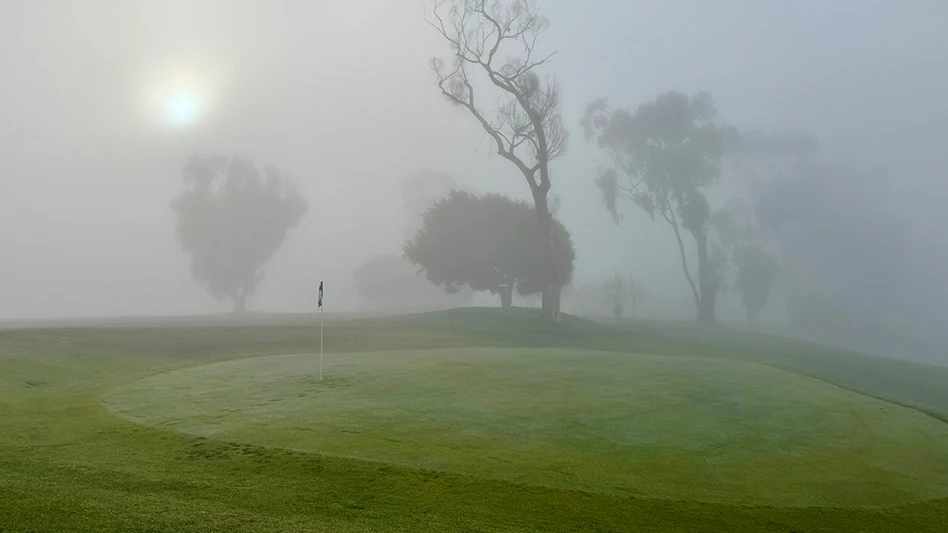In nearly every issue of Golf Course News there’s an announcement of yet another revolutionary advance in turfgrass varieties. Startling breakthroughs of new grasses seem to spring out of nowhere. But to the scientist working in varietal research and development, the development process of tomorrow’s turfgrasses is fairly methodical, requiring up to 10 years from beginning to end. Grasses that are in the conception stage right now will not become commercial until 2010 or beyond.
Before I look ahead to the future of turfgrasses, I’d like to revisit the predictions I made back in 1993. Many of my predictions have come true, that is, if you ignore the part where I foretold that we’d all be commuting to work via rocket packs. I was correct in my vision that bentgrasses would become denser, with more species to choose from, that bluegrasses would become darker and more disease-resistant, and that tall fescue would look more like bluegrass. I was wrong in my prediction that endophytes would become more important than ever. Endophytes are the beneficial insect-fighting fungi in certain turfgrasses. They were new and exciting in 1993, but no one seems to care or even talk about them anymore.
THE FUTURE OF BIOTECH
Many pundits have predicted that turfgrasses would dutifully follow the agronomic crops in embracing biotechnology. Biotech varieties now make up two-thirds of the U.S. cropland of cotton, soybean and corn. Yet despite of the fabulous success of biotech crops, we’ve yet to see the first pound of biotech turf seed sold.
For the foreseeable future, I predict that biotech turfgrasses will have a slow and rocky acceptance. Even 10 years from now, I see that only a small fraction of turf will contain lab-inserted genes. Here are my reasons why:
Cost – With biotech turf, everybody has their hand out. First, you owe a royalty to the developer of the method for inserting the gene, then you owe a royalty to the maker of the gene, its promotor and its terminator. Of course, you want the gene in a good variety, so there’s a royalty to the breeder. And if that’s not bad enough, the regulatory process for a single turf variety appears to be in the range of registering a commercial pesticide – in the realm of millions of dollars. The price of the final product will be out of the reach of all but the price-insensitive part of the golf market.
Traditionalism – Turf managers are happy enough with their lawns that they won’t plow them up to make way for biotech turf. Gene companies are betting that they will. I forecast that they won’t.
The size of the advance – Right now, the advances coming from conventional breeding of turfgrasses are significant compared with the possibilities offered by biotech (see story page 1). Let’s face it, easier weed control is not at the top of most superintendent’s want-lists, and that’s all biotech brings to the table at present.
What about your greens? – You’d think that golf greens would be the prime target for biotech engineers, considering the dollar-values involved. And you’d be wrong. Just as herbicide manufacturers shy away from greens for liability reasons, so will biotechnologists.
BREEDING ADVANCES
Over the next decade, turf development will be done by fewer breeding entities. Already the number of universities involved in turf variety release has plummeted to a fraction of 10 years ago. Companies involved in breeding will also decline. The reason is that the cost of breeding continues to escalate, while the price per pound earned by the product remains the same. You do the math.
Here are my predictions for other changes we’ll see from plant breeders:
Fewer new species will hit the market – Over the last decade, a plethora of new turf species were launched, some with unpronounceable Latin names. Unfortunately, their acceptance by the trade has been less than stellar. As a result, seed company administrators are jaded about the idea of trying it again. I think you’ll see developers stick with the meat-and-potatoes grass species and forget about the escargot.
Seedling vigor will become paramount – As breeding programs produce better and better varieties, the quality differences between varieties will become slivers. Already today, one-fifth of one quality point separates the No. 1 variety in the national test from the No. 60 variety. Most turf managers and many scientists have trouble distinguishing differences five to 10 times greater in side-by-side test plots. Furthermore, most seed company execs make their go-forward decision with a new variety based on its first year in NTEP. They seldom even glance at subsequent years. As a result, varieties that spring from the ground after sowing will be highly prized.
Resistance to evolving disease pathogens – Dollar spot, gray leaf spot, red thread, brown patch and other serious pathogens are rapidly evolving resistance to fungicides and to genes. Breeders and pathogens will play cat-and-mouse to maintain resistance. In the future I predict that varieties may at first appear to be resistant, but later lose their resistance as the pathogen finds the key to their lock.
Regional varieties will prevail – Ten years from now, I envisage that few people will care how a variety performs when averaged across the entire country. Breeding will become so specific that regional varieties will prevail. One shoe will no longer fit all.
Penncross will still be around – Does that variety ever go away? Modern bent varieties are prettier and easier to manage. But even 10 years from now, with advances in breeding and biotech, traditionalists will still be growing Penncross greens.In nearly every issue of Golf Course News there’s an announcement of yet another revolutionary advance in turfgrass varieties. Startling breakthroughs of new grasses seem to spring out of nowhere. But to the scientist working in varietal research and development, the development process of tomorrow’s turfgrasses is fairly methodical, requiring up to 10 years from beginning to end. Grasses that are in the conception stage right now will not become commercial until 2010 or beyond.
Before I look ahead to the future of turfgrasses, I’d like to revisit the predictions I made back in 1993. Many of my predictions have come true, that is, if you ignore the part where I foretold that we’d all be commuting to work via rocket packs. I was correct in my vision that bentgrasses would become denser, with more species to choose from, that bluegrasses would become darker and more disease-resistant, and that tall fescue would look more like bluegrass. I was wrong in my prediction that endophytes would become more important than ever. Endophytes are the beneficial insect-fighting fungi in certain turfgrasses. They were new and exciting in 1993, but no one seems to care or even talk about them anymore.
THE FUTURE OF BIOTECH
Many pundits have predicted that turfgrasses would dutifully follow the agronomic crops in embracing biotechnology. Biotech varieties now make up two-thirds of the U.S. cropland of cotton, soybean and corn. Yet despite of the fabulous success of biotech crops, we’ve yet to see the first pound of biotech turf seed sold.
For the foreseeable future, I predict that biotech turfgrasses will have a slow and rocky acceptance. Even 10 years from now, I see that only a small fraction of turf will contain lab-inserted genes. Here are my reasons why:
Cost – With biotech turf, everybody has their hand out. First, you owe a royalty to the developer of the method for inserting the gene, then you owe a royalty to the maker of the gene, its promotor and its terminator. Of course, you want the gene in a good variety, so there’s a royalty to the breeder. And if that’s not bad enough, the regulatory process for a single turf variety appears to be in the range of registering a commercial pesticide – in the realm of millions of dollars. The price of the final product will be out of the reach of all but the price-insensitive part of the golf market.
Traditionalism – Turf managers are happy enough with their lawns that they won’t plow them up to make way for biotech turf. Gene companies are betting that they will. I forecast that they won’t.
The size of the advance – Right now, the advances coming from conventional breeding of turfgrasses are significant compared with the possibilities offered by biotech (see story page 1). Let’s face it, easier weed control is not at the top of most superintendent’s want-lists, and that’s all biotech brings to the table at present.
What about your greens? – You’d think that golf greens would be the prime target for biotech engineers, considering the dollar-values involved. And you’d be wrong. Just as herbicide manufacturers shy away from greens for liability reasons, so will biotechnologists.
BREEDING ADVANCES
Over the next decade, turf development will be done by fewer breeding entities. Already the number of universities involved in turf variety release has plummeted to a fraction of 10 years ago. Companies involved in breeding will also decline. The reason is that the cost of breeding continues to escalate, while the price per pound earned by the product remains the same. You do the math.
Here are my predictions for other changes we’ll see from plant breeders:
Fewer new species will hit the market – Over the last decade, a plethora of new turf species were launched, some with unpronounceable Latin names. Unfortunately, their acceptance by the trade has been less than stellar. As a result, seed company administrators are jaded about the idea of trying it again. I think you’ll see developers stick with the meat-and-potatoes grass species and forget about the escargot.
Seedling vigor will become paramount – As breeding programs produce better and better varieties, the quality differences between varieties will become slivers. Already today, one-fifth of one quality point separates the No. 1 variety in the national test from the No. 60 variety. Most turf managers and many scientists have trouble distinguishing differences five to 10 times greater in side-by-side test plots. Furthermore, most seed company execs make their go-forward decision with a new variety based on its first year in NTEP. They seldom even glance at subsequent years. As a result, varieties that spring from the ground after sowing will be highly prized.
Resistance to evolving disease pathogens – Dollar spot, gray leaf spot, red thread, brown patch and other serious pathogens are rapidly evolving resistance to fungicides and to genes. Breeders and pathogens will play cat-and-mouse to maintain resistance. In the future I predict that varieties may at first appear to be resistant, but later lose their resistance as the pathogen finds the key to their lock.
Regional varieties will prevail – Ten years from now, I envisage that few people will care how a variety performs when averaged across the entire country. Breeding will become so specific that regional varieties will prevail. One shoe will no longer fit all.
Penncross will still be around – Does that variety ever go away? Modern bent varieties are prettier and easier to manage. But even 10 years from now, with advances in breeding and biotech, traditionalists will still be growing Penncross greens.
Before I look ahead to the future of turfgrasses, I’d like to revisit the predictions I made back in 1993. Many of my predictions have come true, that is, if you ignore the part where I foretold that we’d all be commuting to work via rocket packs. I was correct in my vision that bentgrasses would become denser, with more species to choose from, that bluegrasses would become darker and more disease-resistant, and that tall fescue would look more like bluegrass. I was wrong in my prediction that endophytes would become more important than ever. Endophytes are the beneficial insect-fighting fungi in certain turfgrasses. They were new and exciting in 1993, but no one seems to care or even talk about them anymore.
THE FUTURE OF BIOTECH
Many pundits have predicted that turfgrasses would dutifully follow the agronomic crops in embracing biotechnology. Biotech varieties now make up two-thirds of the U.S. cropland of cotton, soybean and corn. Yet despite of the fabulous success of biotech crops, we’ve yet to see the first pound of biotech turf seed sold.
For the foreseeable future, I predict that biotech turfgrasses will have a slow and rocky acceptance. Even 10 years from now, I see that only a small fraction of turf will contain lab-inserted genes. Here are my reasons why:
Cost – With biotech turf, everybody has their hand out. First, you owe a royalty to the developer of the method for inserting the gene, then you owe a royalty to the maker of the gene, its promotor and its terminator. Of course, you want the gene in a good variety, so there’s a royalty to the breeder. And if that’s not bad enough, the regulatory process for a single turf variety appears to be in the range of registering a commercial pesticide – in the realm of millions of dollars. The price of the final product will be out of the reach of all but the price-insensitive part of the golf market.
Traditionalism – Turf managers are happy enough with their lawns that they won’t plow them up to make way for biotech turf. Gene companies are betting that they will. I forecast that they won’t.
The size of the advance – Right now, the advances coming from conventional breeding of turfgrasses are significant compared with the possibilities offered by biotech (see story page 1). Let’s face it, easier weed control is not at the top of most superintendent’s want-lists, and that’s all biotech brings to the table at present.
What about your greens? – You’d think that golf greens would be the prime target for biotech engineers, considering the dollar-values involved. And you’d be wrong. Just as herbicide manufacturers shy away from greens for liability reasons, so will biotechnologists.
BREEDING ADVANCES
Over the next decade, turf development will be done by fewer breeding entities. Already the number of universities involved in turf variety release has plummeted to a fraction of 10 years ago. Companies involved in breeding will also decline. The reason is that the cost of breeding continues to escalate, while the price per pound earned by the product remains the same. You do the math.
Here are my predictions for other changes we’ll see from plant breeders:
Fewer new species will hit the market – Over the last decade, a plethora of new turf species were launched, some with unpronounceable Latin names. Unfortunately, their acceptance by the trade has been less than stellar. As a result, seed company administrators are jaded about the idea of trying it again. I think you’ll see developers stick with the meat-and-potatoes grass species and forget about the escargot.
Seedling vigor will become paramount – As breeding programs produce better and better varieties, the quality differences between varieties will become slivers. Already today, one-fifth of one quality point separates the No. 1 variety in the national test from the No. 60 variety. Most turf managers and many scientists have trouble distinguishing differences five to 10 times greater in side-by-side test plots. Furthermore, most seed company execs make their go-forward decision with a new variety based on its first year in NTEP. They seldom even glance at subsequent years. As a result, varieties that spring from the ground after sowing will be highly prized.
Resistance to evolving disease pathogens – Dollar spot, gray leaf spot, red thread, brown patch and other serious pathogens are rapidly evolving resistance to fungicides and to genes. Breeders and pathogens will play cat-and-mouse to maintain resistance. In the future I predict that varieties may at first appear to be resistant, but later lose their resistance as the pathogen finds the key to their lock.
Regional varieties will prevail – Ten years from now, I envisage that few people will care how a variety performs when averaged across the entire country. Breeding will become so specific that regional varieties will prevail. One shoe will no longer fit all.
Penncross will still be around – Does that variety ever go away? Modern bent varieties are prettier and easier to manage. But even 10 years from now, with advances in breeding and biotech, traditionalists will still be growing Penncross greens.In nearly every issue of Golf Course News there’s an announcement of yet another revolutionary advance in turfgrass varieties. Startling breakthroughs of new grasses seem to spring out of nowhere. But to the scientist working in varietal research and development, the development process of tomorrow’s turfgrasses is fairly methodical, requiring up to 10 years from beginning to end. Grasses that are in the conception stage right now will not become commercial until 2010 or beyond.
Before I look ahead to the future of turfgrasses, I’d like to revisit the predictions I made back in 1993. Many of my predictions have come true, that is, if you ignore the part where I foretold that we’d all be commuting to work via rocket packs. I was correct in my vision that bentgrasses would become denser, with more species to choose from, that bluegrasses would become darker and more disease-resistant, and that tall fescue would look more like bluegrass. I was wrong in my prediction that endophytes would become more important than ever. Endophytes are the beneficial insect-fighting fungi in certain turfgrasses. They were new and exciting in 1993, but no one seems to care or even talk about them anymore.
THE FUTURE OF BIOTECH
Many pundits have predicted that turfgrasses would dutifully follow the agronomic crops in embracing biotechnology. Biotech varieties now make up two-thirds of the U.S. cropland of cotton, soybean and corn. Yet despite of the fabulous success of biotech crops, we’ve yet to see the first pound of biotech turf seed sold.
For the foreseeable future, I predict that biotech turfgrasses will have a slow and rocky acceptance. Even 10 years from now, I see that only a small fraction of turf will contain lab-inserted genes. Here are my reasons why:
Cost – With biotech turf, everybody has their hand out. First, you owe a royalty to the developer of the method for inserting the gene, then you owe a royalty to the maker of the gene, its promotor and its terminator. Of course, you want the gene in a good variety, so there’s a royalty to the breeder. And if that’s not bad enough, the regulatory process for a single turf variety appears to be in the range of registering a commercial pesticide – in the realm of millions of dollars. The price of the final product will be out of the reach of all but the price-insensitive part of the golf market.
Traditionalism – Turf managers are happy enough with their lawns that they won’t plow them up to make way for biotech turf. Gene companies are betting that they will. I forecast that they won’t.
The size of the advance – Right now, the advances coming from conventional breeding of turfgrasses are significant compared with the possibilities offered by biotech (see story page 1). Let’s face it, easier weed control is not at the top of most superintendent’s want-lists, and that’s all biotech brings to the table at present.
What about your greens? – You’d think that golf greens would be the prime target for biotech engineers, considering the dollar-values involved. And you’d be wrong. Just as herbicide manufacturers shy away from greens for liability reasons, so will biotechnologists.
BREEDING ADVANCES
Over the next decade, turf development will be done by fewer breeding entities. Already the number of universities involved in turf variety release has plummeted to a fraction of 10 years ago. Companies involved in breeding will also decline. The reason is that the cost of breeding continues to escalate, while the price per pound earned by the product remains the same. You do the math.
Here are my predictions for other changes we’ll see from plant breeders:
Fewer new species will hit the market – Over the last decade, a plethora of new turf species were launched, some with unpronounceable Latin names. Unfortunately, their acceptance by the trade has been less than stellar. As a result, seed company administrators are jaded about the idea of trying it again. I think you’ll see developers stick with the meat-and-potatoes grass species and forget about the escargot.
Seedling vigor will become paramount – As breeding programs produce better and better varieties, the quality differences between varieties will become slivers. Already today, one-fifth of one quality point separates the No. 1 variety in the national test from the No. 60 variety. Most turf managers and many scientists have trouble distinguishing differences five to 10 times greater in side-by-side test plots. Furthermore, most seed company execs make their go-forward decision with a new variety based on its first year in NTEP. They seldom even glance at subsequent years. As a result, varieties that spring from the ground after sowing will be highly prized.
Resistance to evolving disease pathogens – Dollar spot, gray leaf spot, red thread, brown patch and other serious pathogens are rapidly evolving resistance to fungicides and to genes. Breeders and pathogens will play cat-and-mouse to maintain resistance. In the future I predict that varieties may at first appear to be resistant, but later lose their resistance as the pathogen finds the key to their lock.
Regional varieties will prevail – Ten years from now, I envisage that few people will care how a variety performs when averaged across the entire country. Breeding will become so specific that regional varieties will prevail. One shoe will no longer fit all.
Penncross will still be around – Does that variety ever go away? Modern bent varieties are prettier and easier to manage. But even 10 years from now, with advances in breeding and biotech, traditionalists will still be growing Penncross greens.

Explore the July 2003 Issue
Check out more from this issue and find your next story to read.
Latest from Golf Course Industry
- KemperSports and Touchstone Golf announce partnership
- PBI-Gordon Company hires marketing manager Jared Hoyle
- Mountain Sky Guest Ranch announces bunker enhancement project
- GCSAA names Joshua Tapp director of environmental programs
- AQUA-AID Solutions bolsters Sunshine State presence
- Escalante Golf acquires secluded Illinois course
- Tartan Talks 105: Nathan Crace and Todd Quitno
- Disease Discussion 24: Let the turf talk to you





